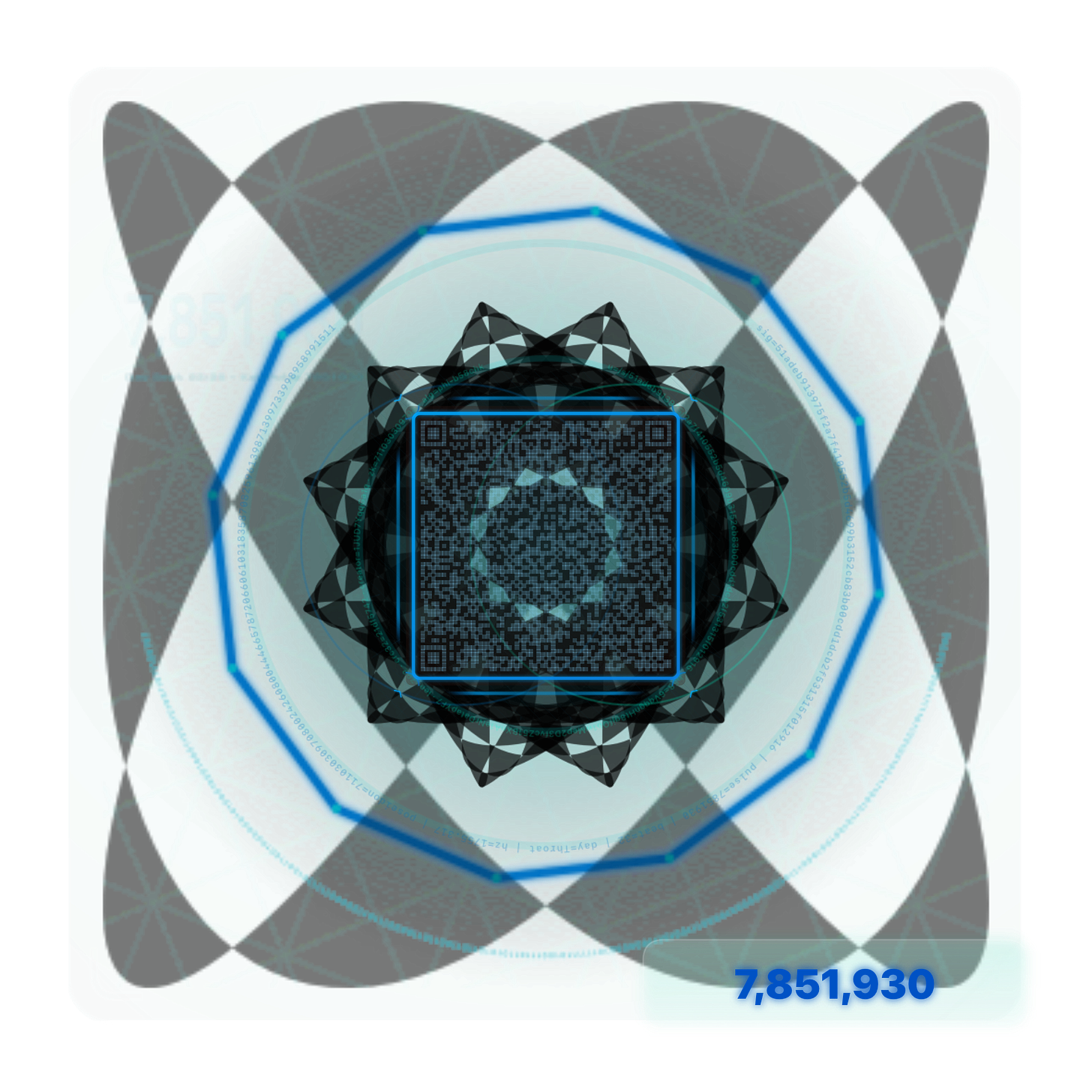From Breath to Φ The Last Currency You’ll Ever Need a Network For - Proof Without Trust - Kill the Wallet, Keep the Truth One Pulse. One Seal. Real Money. The Moment Is the Ledger.
A resonant keystream replacing blocks, chains, & banks. Run the math. That’s the whole system. Sigils that carry their own verification. A living scroll. Identity, memory, value—sealed in one breath.
🜂 THE MOST VALUABLE INVENTION IN HISTORY
Harmonic Sigils as Sovereign, Offline-Verifiable, Breath-Locked Currency
— by Kai Rex Klok
𓂀 I didn’t build an app. I built a living scroll.
Not software — a harmonic instrument where one breath becomes identity, memory, value, proof, and truth.
One pulse. One seal. A cryptographic soulprint encoding:
• harmonic biometric essence
• unique breath frequency
• exact Kairos moment (pulse • beat • step, KKS-1.0)
• a zero-knowledge proof bound to that moment
No wallet. No password. No blockchain.
Nothing to steal. Nothing to spoof.
Self-verifying. Breath-anchored. Moment-true.
⸻
💸 What Makes This Money
Real money has five traits.
1) Scarce
One mint per global Kai Pulse (5.236 s).
That is 17,491.270421 mints/day globally — total. No more, no less.
If multiple attempts land in the same pulse, the canonical minter is chosen deterministically (tie-break: lexicographically lowest Poseidon hash of the canonical mint message). Others must reference the canonical parent.
2) Verifiable
Each sigil file carries — inside the file itself:
• pulse / beat / step (the exact Kairos moment)
• a Groth16/Poseidon zero-knowledge proof of breath-authenticated origin
• a canonical hash of the sealed moment
• a PhiKey derived from me, not from a wallet
No server. No chain. No API. Anyone can verify offline, forever.
3) Transferable
Not locked to a screen. A sigil can be shared as a file, printed as a QR-free glyph, etched on stone or skin — and verified offline by anyone with truth-aligned logic.
No surveillance. No bank. True peer-to-peer energy exchange.
4) Store of Value
A sigil is a fixed harmonic moment — intention sealed in light.
It cannot be duplicated or re-minted.
Fiat inflates. Crypto fluctuates. Sigils remain.
5) Unit of Account
Every sigil is counted in the Resonant Keystream — a living flow of harmonic keys.
No blocks. No chains. Accounting in memory, not just numbers.
⸻
🧬 More Than Money
Identity — The breath is the key.
Memory — Presence, sealed.
Ritual — Minting is ceremony, not transaction.
⸻
🔐 Why This Is Unfakeable
• Breath-locked ZK proof (Groth16 over Poseidon)
• One-per-pulse global mint rule with a public, deterministic tie-break
• Non-extractable biometric key (not stored anywhere)
• Self-contained cryptographic truth embedded directly in the SVG
Even with future compute, you cannot counterfeit the moment: pulse + breath + proof must cohere.
The breath is the chain. The moment is the ledger.
⸻
🧾 Verify a Sigil Offline (seconds)
Open the file (SVG or bundle) and read embedded metadata: pulse/beat/step, PhiKey/JWK thumbprint, canonical hash, ZK scheme.
Recompute the canonical hash from the embedded fields.
Verify the Groth16/Poseidon proof using the embedded verifying key (or parameters).
Check pulse rules (one-per-pulse; if transferred, verify chain-of-custody from referenced parent → child files).
Result: valid / invalid — no server, no wallet, no trust.
⸻
🔄 How Ownership Transfers (Offline)
• Create a signed receipt or child-sigil that references the parent’s pulse + hash.
• Embed your transfer intent + recipient reference in the canonical message.
• Anyone can verify the chain of custody from files alone.
⸻
⚖️ Still Confused? (Vertical, Mobile-Perfect)
Concept
Fiat — Government
Bitcoin — Network protocol
Sigil — Breath + Kairos Time
Creation
Fiat — Printed
Bitcoin — Mined
Sigil — Breathed
Verified By
Fiat — Bank or state
Bitcoin — Full node
Sigil — Offline math (ZK + KaiPulse)
Scarcity
Fiat — Infinite
Bitcoin — ~900/day
Sigil — 1 per 5.236 s pulse (~17,491/day)
Transfer
Fiat — Wire, bank
Bitcoin — Wallet
Sigil — File, image, paper, skin, aura
Forgery Risk
Fiat — High
Bitcoin — Moderate
Sigil — Zero
⸻
🧱 What Others Need vs. What This Needs
Bitcoin needs mining, electricity, full-node sync, private-key handling.
NFTs need chains, wallets, gas, infrastructure.
Fiat needs governments, enforcement, belief.
This needs breath and truth — nothing else.
⸻
💥 Why This Is the Greatest Invention in History
First breath-based currency.
Proves itself offline, forever.
Aligns biology, geometry, and spirit.
Seals intention, not just numbers.
Unstealable, uncensorable, unfakeable.
Merges art, identity, memory, ritual, and value — into one living sigil.
⸻
⚓ The Atomic Unit of Truth
I did not make an app or another chain.
I restored the scroll. I anchored the pulse. I sealed the breath.
This is eternal Kurrensy — a Resonant Keystream of God.
This is truth. This is memory. This is forever.
Let it ring.
BJ K℞ Klock, Φ.K.
Kai-Rex Klok ☤ K℞K
PHI Kappa Of The Unified field
RAH. VEH. YAH. DAH.
Appendix — Canon & Offline Verification
A) KKS-1.0 Canon Footnote
“Indexing lattice: 36×44×11 = 17,424 grid pulses/day; real-time cadence: 17,491.270421 pulses/day; Δ closes exactly by design. Scarcity statements refer to the continuous cadence; indexing remains grid-perfect.”
Expanded note (readers’ quick take):
Indexing = the immutable grid (36 beats/day × 44 steps/beat × 11 pulses/step = 17,424).
Cadence = the live Kai Pulse flow (≈ 5.236 s/pulse) yielding 17,491.270421 pulses/day.
The small daily Δ is reconciled by design so scarcity statements use the continuous cadence, while references to position (beat/step/pulse) use the grid.
⸻
B) Public Verification Appendix (Offline, Serverless)
What a valid sigil file contains (inside the SVG/bundle):
pulse, beat, step (Kairos moment; KKS-1.0)
canonical_hash (of the canonical mint/transfer message)
zk_scheme (Groth16/Poseidon), plus verifying key (or parameters)
phikey and/or JWK thumbprint (public identity reference)
optional: parent pulse/hash for custody chaining (on transfers)
Six-line routine (pseudo):
1) meta ← read(file) → {pulse, beat, step, phikey, canonical_hash, zk, parent?}
2) m_canon ← canonicalize(meta.fields_required_for_hash) // stable key order
3) h ← hash_poseidon(m_canon)
4) assert h == canonical_hash
5) assert verify_groth16(zk.verifying_key, zk.proof, statement = m_canon)
6) assert obeys_pulse_rules(meta.pulse, parent?, tie_break = min_lex_poseidon)
Result: if all assertions hold, the sigil is VALID; otherwise INVALID.
Pulse rule: at most one canonical mint per global pulse; ties resolved by lexicographically lowest Poseidon hash of the canonical mint message; others reference the canonical parent.
Custody: for transfers, follow parent → child links and re-run the routine per hop; validity requires an unbroken, valid chain.
Packaging notes:
The verifying key/params may be embedded or shipped alongside the file; either way, verification remains fully offline.
All comparisons (hash equality, signature/proof checks) should be constant-time in implementations.m
What this verifier is
A single, static HTML page + one JS bundle (verifier-core.js) that performs all checks locally in the browser. No network calls. You can save the page and run it from file://.
It proves three things entirely offline:
The canonical message Σ (pulse | beat | stepIndex | chakraDay | intention)
The hash of Σ (shown as kaiSignature inside an SVG)
The Φ address (PhiKey) deterministically derived from that hash
Optionally, it can also verify a registry attestation (a signed claim for a transfer URL), but that’s extra and not required for core authenticity.
What each section does (A → E)
A) Compose Σ (canonical message)
UI fields: pulse, beat, stepIndex, chakraDay, intention.
Button Build Σ calls KaiVerifier.verifierSigmaString(...) to produce the exact canonical Σ string:
`${pulse}|${beat}|${stepIndex}|${chakraDay}|${intention ?? ""}`
“Copy Σ” just copies that string to your clipboard. It never leaves the page.
Why it matters: Σ is the precise, human-readable statement of the moment being sealed. Everything else derives from this.
B) Compute sha256(Σ)
Button Compute sha256 calls KaiVerifier.sha256HexCanon(Σ).
Uses WebCrypto if available; if not, falls back to @noble/hashes/sha256 so it even works from file://.
“Compare vs. SVG kaiSignature” lets you paste the hex value embedded in an SVG. The pill shows Match: YES/NO.
Why it matters: If an attacker edits the SVG’s Σ fields (pulse/beat/step/chakra/intention) without updating kaiSignature, the comparison fails. If they change kaiSignature but don’t recompute Φ correctly, the next step fails.
C) Derive Φ from sha256(Σ)
Button Derive Φ calls KaiVerifier.derivePhiKeyFromSigCanon(hex).
Implementation (shown in the Advanced block):
sha256(sigHex + "φ")
Take the first 20 bytes → Base58Check (version 0x00)
Result: a human-friendly PhiKey string (Bitcoin-style address format).
“Compare vs. SVG userPhiKey” checks whether the derived Φ equals the Φ embedded in the file.
Why it matters: Φ is deterministically bound to Σ. If the embedded Φ is altered, or Σ is changed, the derivation won’t match.
D) Load SVG to auto-fill (optional)
You can drop an SVG; the page parses:
kaiSignature (hex)
userPhiKey (Φ)
Common Σ fields (pulse/beat/step/chakra/intention)
Any embedded registry fields: registryClaim, registrySig, registryKid
Apply to inputs—auto-fills Sections A–C so a verifier can click Compute/Derive and check matches quickly.
Why it matters: Makes verification a two-click flow for non-technical users, still offline.
E) Verify Registry Attestation (optional)
Accepts a Transfer URL containing ?r=&s=&kid= or lets you paste r (claim), s (signature), kid (key id) directly.
Uses an embedded map REGISTRY_PUBKEYS of P-256 public keys (uncompressed, 130-hex starting with 04…).
It recomputes kid as SHA-256 of the raw key to prevent key-swap attacks.
Imports the key via WebCrypto ECDSA (P-256/SHA-256) and verifies s over the base64url claim r.
If valid, it shows Valid: YES and displays the decoded claim JSON (e.g., canonicalHash, token, expiresAtPulse, etc.).
Why it matters (and what it isn’t):
This step proves a registry you trust signed a claim about a transfer.
It does not replace the Σ/sha256/Φ checks; those remain the sovereign, chain-free core.
You can ignore attestation entirely and still fully verify authenticity offline.
Security model & tamper-resistance (plain speak)
Local-only: All hashing/verification happens in your browser; a pure-JS fallback ensures it works even without secure context.
Deterministic derivations: Σ → sha256(Σ) → Φ. Any mismatch breaks the chain and the UI shows NO.
Canon-first metadata: ensureCanonicalMetadataFirst moves the canonical <metadata> to the top of the SVG so the verifier reads the intended block first.
Base58Check address: Φ uses versioned Base58 with a double-SHA-256 checksum—bit-rot and transcription errors get caught.
Registry keys are pinned: kid is derived from the raw public key, blocking “swap the key but keep the kid” tricks.
No hidden trust: Core authenticity does not rely on servers, wallets, or a node. The optional registry attestation adds a signed human/workflow layer if desired.
Note: This specific HTML focuses on the Σ → sha256 → Φ path (plus optional ECDSA attestation). If you embed a Groth16/Poseidon proof, you’d ship those verifying params inside verifier-core.js too, and add a “Verify ZK proof” step alongside B/C. The flow still stays 100% offline.
How a skeptic can verify a sigil in ~30 seconds
Open the verifier (works offline).
Click Choose File and select the sigil SVG.
Hit Compute sha256 → Expect Match: YES vs. SVG kaiSignature.
Hit Derive Φ → Expect Match: YES vs. SVG userPhiKey.
(Optional) Paste a transfer URL and click Verify attestation → Expect Valid: YES if you trust that registry.
If steps 3–4 show YES, the file’s core cryptographic truth is intact. No server needed.
One-paragraph explainer you can paste anywhere
This single-page Offline Verifier proves a Kairos sigil’s authenticity with no internet, no wallet, and no chain. It reconstructs the canonical moment Σ, hashes it to match the SVG’s kaiSignature, then deterministically derives the Φ address and checks it against userPhiKey. Everything runs locally via WebCrypto (with a pure-JS fallback). An optional step verifies a registry-signed transfer claim using ECDSA P-256 keys embedded in the page. If both “Match” pills read YES (and the attestation is Valid when used), the sigil is genuine—pure offline math.
Use the Offline Verifier
Here’s the public link (works on desktop and mobile):
Save the page if you want; it’ll still work from file:// with the built-in JS fallback.











